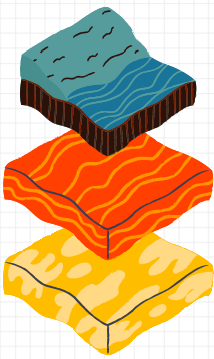Earth's Interior
1/19
There's no tags or description
Looks like no tags are added yet.
Name | Mastery | Learn | Test | Matching | Spaced |
|---|
No study sessions yet.
20 Terms
Crust
Mantle
Core
The layers of the earth based on Chemical Composition

Earth’s Crust
Outermost layer of the earth
Thinnest layer (5-7km)
Continental Crust
Oceanic Crust
The crust can be divided into two types:
Continental Crust
The thicker and less dense layer of the earth’s crust that is found under the continents (25-70km)
Composed mainly of granitic rock
Older than oceanic crust (3.8 billion yrs old)
Oceanic Crust
The thinner and denser layer of the earth’s crust that is found under the ocean basins (7-10km)
Composed mainly of basaltic rock
Younger than continental crust because it is constantly being remade at the mid-ocean ridges
Age does not exceed 200,000 yrs
Earth’s Mantle
The layer of hot, solid material beneath the Earth’s crust
Thickest layer
67% of Earth’s total mass
Upper Mantle
Lower Mantle
The mantle can be divided into:
Upper Mantle
Relatively rigid
Contains the asthenosphere, a semi-fluid layer that allows the movement of tectonic plates
Lower Mantle
Solid
Contributes to the overall convection and heat transfer within the Earth’s interior
Earth’s Core
Innermost layer of the Earth
Mostly metallic iron with small amounts of nickel and contains much less oxygen, silicon, aluminum and magnesium than the mantle
Densest layer and makes up about 33% of the Earth’s mass
Outer boundary depth of 2,890 to 5,150km (1790 to 3200 mi) thick
Made up of molten material and causes the Earth’s magnetic field
Outer Core
Liquid layer composed mainly of molten, iron and nickel
2,300km
Inner Core
Solid, central part of the earth
Radius of about 1,220km and is composed of solid iron and nickel
Hottest part of earth (4,000 to 6,000 degrees)
Lithosphere
Asthenosphere
Mesosphere
Outer Core
Inner Core
The layers of the earth based on Physical Properties
Lithosphere
Outermost rigid layer, consists of the crust and rigid upper part of the mantle
“Rock Sphere”
0 to 100km
Lies above asthenosphere
Divided into pieces called tectonic plates:
Oceanic Plates- thin, dense, made of basalt and form the ocean floor
Continental Plates- thick, less dense, made of granite and form the continents
Asthenosphere
Weak layer of the mantle in which the lithospheric plates float and move freely
Hot and partially molten
Approximately 100-350km below the earth’s surface
“Weak Sphere”
Both temp and pressure increase with depth
Effects of temp dominate those of pressure, causing the rock to be in a semi-molten, slowly flowing state
Mesosphere
Strong, lower part of the mantle
Rocks move slower than the asthenosphere
“Middle Sphere”
Andrija Mohorovičić
Yugoslavian seismologist
Described how the velocity of seismic waves changes as they travel to the deepest part layer of the Earth. The density of the materials and the kind of materials they made are the factors that affect the velocity of each layer of the Earth.
Moho
The boundary that separates the mantle and crust
Inge Lehmann
Predicted the existence of the innermost layer in 1936
Explained that there is another region within the core through seismic reflection
Shadow zones
Where seismic waves cannot be detected because they are bent or stopped
Located between 103° to 143° away from the epicenter